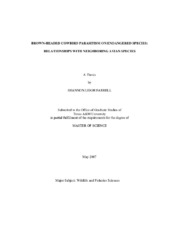| dc.description.abstract | Brown-headed cowbird (Molothrus ater) parasitism on the endangered black-capped
vireo (Vireo atricapilla) is a management concern. Management for black-capped
vireos in east-central Texas has focused on habitat restoration through vegetation
modification. Loss of productivity due to parasitism, however, may limit the potential
habitat restoration in restoring black-capped vireo populations. I investigated the
relationships between frequency of parasitism on black-capped and white-eyed (V.
griseus) vireos and characteristics of the neighboring avian assemblage to identify avian
characteristics useful for predicting expected frequency of parasitism. I located and
monitored vireo nests in March–July 2006 to determine frequency of cowbird parasitism
on the 2 vireo species on 6 study sites on private land in east-central Texas. I conducted
100-m-radius circular-plot point count surveys on study sites from 1 April– 31 June
2006 to identify neighboring avian assemblages.
All black-capped vireo nests (n = 20) and 81% of white-eyed vireo nests (n =
27) were parasitized. Species richness, species evenness, cumulative bird abundance,
and cowbird host abundance did not differ significantly among study sites. Parasitism
frequency was positively correlated with the number of cowbirds detected (r2 = 0.673, P= 0.045). Parasitism frequency was negatively correlated with abundance (r2 = 0.687, P
= 0.042) and proportion of (r2 = 0.692, P = 0.040) of black-and-white warblers
(Mniotilta varia), known cowbird hosts. I did not find a relationship between parasitism
frequency and abundance of other cowbird hosts. The relationship between black-andwhite
warbler abundance and parasitism frequency may reflect an interaction between
parasitism and the vegetation characteristics associated with black-and-white warblers,
suggesting the need for future study of the relationships between parasitism frequency
and vegetation characteristics in the study region. The frequency of parasitism I
observed suggests that cowbird control may be an important management tool if
management objectives in the study region continue to include recovery of black-capped
vireo populations. Number of cowbirds may be a reasonable predictor of expected
parasitism frequency in an area, which may be useful to land managers in selecting areas
for implementation of cowbird control. | en |


